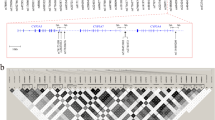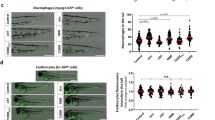Abstract
Two known polymorphisms in the 5′ enhancer region (ER) of the thymidylate synthase (TS) gene, a variable number of tandem repeats of a 28 bp sequence (2R/3R) and a further G>C single nucleotide substitution within the repeats, result in genotypes with 0–5 functional upstream stimulatory factor (USF) E-box consensus elements. However, the relationship between these polymorphisms, regulation of TS expression and patient response to fluoropyrimidine treatment has been inconsistent. In this study, seven possible TSER allele configurations showed similar patterns of luciferase gene expression regardless of cell type or USF-1 content, with no significant difference in promoter activity between the wild-type 2RGC and 3RGGC (1.40±0.37 vs 1.43±0.32, P=0.90), whereas the minor alleles, 2RCC and 3RGCC, were significantly reduced (0.84±0.17, P=0.01) and increased (3.19±0.72, P=0.001) respectively. Patient plasma levels of 2′-deoxyuridine, a surrogate marker of TS activity, were significantly different between genotypes (P<0.001) and inversely related to luciferase activity (P=0.02) but not to the absolute number of functional repeated elements (P=0.16), suggesting that the position, rather than the number of functional USF E-box repeats in the TSER, is responsible for determining gene expression in vitro and TS activity in vivo.
This is a preview of subscription content, access via your institution
Access options
Subscribe to this journal
Receive 6 print issues and online access
$259.00 per year
only $43.17 per issue
Buy this article
- Purchase on Springer Link
- Instant access to full article PDF
Prices may be subject to local taxes which are calculated during checkout




Similar content being viewed by others
References
Taylor GA, Dady PJ, Harrap KR . Quantitative high-performance liquid chromatography of nucleosides and bases in human plasma. J Chromatogr 1980; 183: 421–431.
Ford HE, Mitchell F, Cunningham D, Farrugia DC, Hill ME, Rees C et al. Patterns of elevation of plasma 2′-deoxyuridine, a surrogate marker of thymidylate synthase (TS) inhibition, after administration of two different schedules of 5-fluorouracil and the specific TS inhibitors raltitrexed (Tomudex) and ZD9331. Clin Cancer Res 2002; 8: 103–109.
Li KM, Rivory LP, Clarke SJ . Rapid quantitation of plasma 2′-deoxyuridine by high-performance liquid chromatography/atmospheric pressure chemical ionization mass spectrometry and its application to pharmacodynamic studies in cancer patients. J Chromatogr B Analyt Technol Biomed Life Sci 2005; 820: 121–130.
Kaneda S, Takeishi K, Ayusawa D, Shimizu K, Seno T, Altman S . Role in translation of a triple tandemly repeated sequence in the 5′-untranslated region of human thymidylate synthase mRNA. Nucleic Acids Res 1987; 15: 1259–1270.
Horie N, Aiba H, Oguro K, Hojo H, Takeishi K . Functional analysis and DNA polymorphism of the tandemly repeated sequences in the 5′-terminal regulatory region of the human gene for thymidylate synthase. Cell Struct Funct 1995; 20: 191–197.
Luo H-R, Lü XM, Yao Y-G, Horie N, Takeishi K, Jorde LB et al. Length polymorphism of thymidylate synthase regulatory region in Chinese populations and evolution of the novel alleles. Biochem Genet 2002; 40: 41–51.
Marsh S, Ameyaw MM, Githang'a J, Indalo A, Ofori-Adjei D, Howard L . McLeod, novel thymidylate synthase enhancer region alleles in African populations. Hum Mutat 2000; 16: 528.
Marsh S, Collie-Duguid ES, Li T, Liu X, McLeod HL . Ethnic variation in the thymidylate synthase enhancer region polymorphism among Caucasian and Asian populations. Genomics 1999; 58: 310–312.
Kawakami K, Salonga D, Park JM, Danenberg KD, Uetake H, Brabender J et al. Different lengths of a polymorphic repeat sequence in the thymidylate synthase gene affect translational efficiency but not its gene expression. Clin Cancer Res 2001; 7: 4096–4101.
Kawakami K, Omura K, Kanehira E, Watanabe Y . Polymorphic tandem repeats in the thymidylate synthase gene is associated with its protein expression in human gastrointestinal cancers. Anticancer Res 1999; 19: 3249–3252.
Mandola MV, Stoehlmacher J, Muller-Weeks S, Cesarone G, Yu MC, Lenz HJ et al. A novel single nucleotide polymorphism within the 5′ tandem repeat polymorphism of the thymidylate synthase gene abolishes USF-1 binding and alters transcriptional activity. Cancer Res 2003; 63: 2898–2904.
Kawakami K, Watanabe G . Identification and functional analysis of single nucleotide polymorphism in the tandem repeat sequence of thymidylate synthase gene. Cancer Res 2003; 63: 6004–6007.
Lincz LF, Scorgie FE, Garg MB, Ackland SP . Identification of a novel single nucleotide polymorphism in the first tandem repeat sequence of the thymidylate synthase 2R allele. Int J Cancer 2007; 120: 1930–1934.
Gusella M, Bolzonella C, Crepaldi G, Ferrazzi E, Padrini R . A novel G/C single-nucleotide polymorphism in the double 28-bp repeat thymidylate synthase allele. Pharmacogenomics J 2006; 6: 421–424.
Yawata A, Kim SR, Miyajima A, Kubo T, Ishida S, Saito Y et al. Polymorphic tandem repeat sequences of the thymidylate synthase gene correlates with cellular-based sensitivity to fluoropyrimidine antitumor agents. Cancer Chemother Pharmacol 2005; 56: 465–472.
Hishida A, Matsuo K, Hamajima N, Ito H, Ogura M, Kagami Y et al. Associations between polymorphisms in the thymidylate synthase and serine hydroxymethyltransferase genes and susceptibility to malignant lymphoma. Haematologica 2003; 88: 159–166.
Horie N, Takeishi K . Identification of functional elements in the promoter region of the human gene for thymidylate synthase and nuclear factors that regulate the expression of the gene. J Biol Chem 1997; 272: 18375–18381.
Li KM, Rivory LP, Hoskins J, Sharma R, Clarke SJ . Altered deoxyuridine and thymidine in plasma following capecitabine treatment in colorectal cancer patients. Br J Clin Pharmacol 2007; 63: 67–74.
Cox S, Harmenberg J . Assay of intracellular thymidylate synthetase activity and inhibition by 5-fluoro-2′-deoxyuridine in lymphocytes. J Biochem Biophys Methods 1992; 25: 17–23.
Mauritz R, Giovannetti E, Beumer IJ, Smid K, Van Groeningen CJ, Pinedo HM et al. Polymorphisms in the enhancer region of the thymidylate synthase gene are associated with thymidylate synthase levels in normal tissues but not in malignant tissues of patients with colorectal cancer. Clin Colorectal Cancer 2009; 8: 146–154.
Acknowledgements
This work was supported by funding from the Margaret Mitchell and Jane Reid Harle Memorial Grant Schemes, Calvary Mater Newcastle, New South Wales.
Author information
Authors and Affiliations
Corresponding author
Ethics declarations
Competing interests
The authors declare no conflict of interest.
Additional information
Supplementary Information accompanies the paper on The Pharmacogenomics Journal website
Supplementary information
Rights and permissions
About this article
Cite this article
de Bock, C., Garg, M., Scott, N. et al. Association of thymidylate synthase enhancer region polymorphisms with thymidylate synthase activity in vivo. Pharmacogenomics J 11, 307–314 (2011). https://doi.org/10.1038/tpj.2010.43
Received:
Revised:
Accepted:
Published:
Issue Date:
DOI: https://doi.org/10.1038/tpj.2010.43
Keywords
This article is cited by
-
Plasma deoxyuridine as a surrogate marker for toxicity and early clinical response in patients with metastatic colorectal cancer after 5-FU-based therapy in combination with arfolitixorin
Cancer Chemotherapy and Pharmacology (2021)
-
Germline oncopharmacogenetics, a promising field in cancer therapy
Cellular Oncology (2015)



